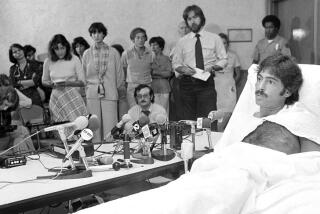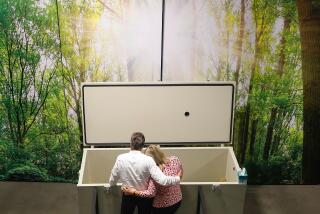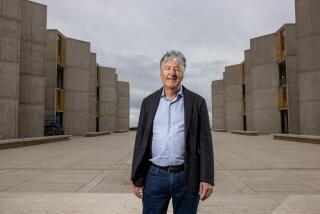Burning Passion Drives Devotees of Cryonics Idea
- Share via
RIVERSIDE — While Riverside County authorities rummaged through the Alcor Life Extension Foundation laboratory last week, searching for a missing human head, Hugh Hixon stood outside the open door, watching the vault where the “suspendees” are stored.
Hixon, as much a devotee as an employee of the laboratory, stood there all day as his bald head reddened in the sun. That night he slept nearby in his car, continuing his vigil.
The “suspendees” are six human heads--including that of Hixon’s father--and one body, frozen in liquid nitrogen to a temperature of about 400 degrees below zero Fahrenheit, awaiting a return to life in the future, when science will be more advanced and life will be forever.
Hixon’s determination was an example of the burning passion that abounds among believers in cryonics, as the reanimation movement is called.
Assails Coroner’s Action
“What the coroner did to us is like someone coming into an intensive care ward with a machete and saying they were going to chop up your relatives,” said Keith Henson, a San Jose computer consultant who plans to be frozen some day at Alcor.
“We do not think of the patients as body parts. To us they are friends who are gravely injured, but the final outcome is still in doubt. I’m going to be joining them someday.”
The bizarre tug-of-war between the Alcor Foundation, one of two cryonics groups in California, and the Riverside County coroner’s office over the still-missing head of 83-year-old Dora Kent has focused national attention on the small but obsessive world of cryonics.
Advocates of cryonics believe that at some uncertain date in the future science will be able to revive the frozen dead. When only a head is preserved, the assumption is that a new body will be cloned. The movement was begun in 1962 by Robert Ettinger, a retired college physics instructor who lives in Michigan, but it has taken hold most strongly in California.
There are now at least four bodies, eight heads, two cats and two dogs in the freezers of Alcor, at the American Cryonics Society of San Francisco and at its affiliated Trans-Time laboratory in Oakland, and Ettinger’s Immortalist Society of Oak Park, Mich.
About 230 people have signed up to join them.
A Canadian group has formed recently with ties to the San Francisco laboratory. A Long Island agency recently began selling cryonic life insurance policies, advertising that death benefits will finance the buyer’s storage in the San Francisco group’s freezer tank.
(Alcor has 98 “suspension members,” who pay $200 a year to become eligible for immediate freezing at the foundation’s laboratory after their deaths. There is also a one-time charge at death of $100,000 to freeze an entire body or $35,000 for a head, money that is supposed to be provided by life insurance policies. Other cryonics groups charge roughly similar fees.)
Ettinger would not comment on Alcor’s situation, saying that he did not have enough facts.
But a leader of the American Cryonics Society, which has feuded recently with Alcor and its president, Mike Darwin, over the best ways to advance cryonics, distanced his group from the Riverside organization.
‘Looks Like Real Good Idea’
“They wanted to go it alone in the past. That looks like a real good idea now,” he said.
So far, Alcor’s dispute with the coroner has led to an unusual court order shielding the foundation’s frozen bodies from being thawed by the coroner; an investigation into possible stolen property at the laboratory, and allegations of zoning and other administrative law violations.
Dora Kent was decapitated at the laboratory on Dec. 11 so that her head could be frozen and preserved. That was two days after her son had moved the woman to the laboratory from an unidentified Riverside-area nursing home.
Coroner’s investigators believe that she was deceased at the time of the decapitation, and conducted an autopsy on her headless body. But medical examiners want the head to complete the autopsy and determine whether Kent died of natural causes or “by some outside agent,” according to Daniel Cupido, the coroner’s supervising investigator.
The cryonicists, who say that the coroner’s tests would harm the head beyond hope of resurrection, will not say where it is, but that it is safely frozen in an insulated canister of liquid nitrogen. Hixon has hinted that the head is under the control of Dora Kent’s son, Saul Kent, 48, a leading figure in the cryonics movement who has donated thousands of dollars to Alcor and to the San Francisco-based American Cryonics Society.
Saul Kent, who moved into the Riverside County community of Woodcrest about a year ago, is also a founder of the Life Extension Foundation of Hollywood, Fla., which is under investigation by the U.S Food and Drug Administration for allegedly distributing unapproved medicines.
Alcor spokesmen have said that Kent has helped finance Alcor, providing a $30,000-a-year subsidy with the profits from the Florida foundation’s sales of vitamins, health food, a newsletter titled the Anti-Aging News and Kent’s book, “The Life-Extension Revolution.”
Kent’s Florida office space was provided rent free by a fellow believer in cryonics, Stephen D. Ruddel, according to William Faloon, vice president of the Florida foundation.
Ruddel pleaded guilty to cocaine-trafficking charges last October. A Florida judge sentenced him to 3 1/2 years probation and ordered him to pay more than $162,000 in penalties, according to the Miami Herald. Ruddel also forfeited the $800,000 building housing the Life Extension Foundation to the U.S. marshal’s office.
Kent has not been available to reporters in recent weeks, nor has he been interviewed by coroner’s investigators.
Question Workers
Investigators, however, have questioned six Alcor workers, including Darwin, the foundation’s president.
Darwin, 32, who said that his attorneys told him not to talk to reporters after the investigation began, is tall and intense. A former hemodialysis technician, he said in an interview last year that he has less than two years of undergraduate biology study. Physicians and respected scientists who have discussed their research with him, however, describe him as impressively self-educated.
Darwin said he legally changed his name from Federowicz to Darwin, after Charles Darwin, originator of the theory of evolution. He said Darwin was originally an insulting high school nickname given him because of his interest in science.
As a 17-year-old on summer vacation, Darwin hitchhiked to California from Indianapolis to visit leaders of an early cryonics group, the Cryonics Society of California.
That society collapsed in 1981 after losing a $1-million lawsuit brought by the relatives of four people whose bodies the society was supposed to be preserving in liquid nitrogen in a crypt in a Chatsworth cemetery.
Witnesses testified that the freezing efforts, supervised by a television repairman who headed the group, did not work and that the society continued to accept thousands of dollars in “maintenance” payments from relatives long after the bodies had begun to decay.
Horrified by Techniques
Alcor had been founded in 1972 by disillusioned Cryonics Society members. Darwin, who said he had been horrified by the society’s techniques, moved to California permanently in 1980 and joined Alcor.
Two Alcor researchers, Jerry Leaf and Dr. Steve Harris, also are on the staff of the UCLA School of Medicine.
Leaf, a research associate in the division of thoracic surgery at UCLA, was the person who surgically decapitated Dora Kent after her death. Harris, whom Saul Kent has described in a court affidavit as his mother’s physician, signed a death certificate listing Dora Kent’s cause of death as pneumonia and heart disease, although he was not present when she died. That death certificate was rejected by Riverside County health officials, who referred the case to the coroner for investigation.
UCLA issued a terse statement Friday saying that “The School of Medicine has initiated a formal review of Dr. Harris’ professional conduct in the Alcor matter as it relates to his continued participation in the training programs of the school.” A UCLA spokesman, who identified Harris as a post-residency trainee in geriatrics and pathology, would not elaborate.
Dr. Glenn Langer, the school’s associate dean for research, stressed that UCLA disapproves of cryonics research, regarding it “as totally invalid, scientifically.”
UCLA campus police searched the Alcor laboratory last week and removed equipment bearing UCLA property tags in what was described as a theft investigation. Alcor spokesmen said they purchased the equipment as surplus property from the UCLA medical school.
Surplus Sales Common
UCLA spokesmen said it had not yet been determined that any of the property was stolen. Surplus sales are common, they said, and the availability of the equipment is well known among employees.
Ray Eden, associate dean of the UCLA School of Medicine, said Leaf once was “counseled” for allowing his affiliation with UCLA to appear on a cryonics-related publication.
Leaf is not a physician and is not licensed to perform surgery on live human beings, but teaches surgical techniques using dogs, and said he has published papers in scientific journals.
Leaf also owns a cryonics laboratory called Cryovita, formerly of Fullerton, now located in the Alcor facility, where he has long been among the most active researchers, according to Alcor spokesmen and publications. At Alcor, Leaf participates in experiments in which the blood of dogs is replaced with a substitute, designed to keep them alive at low temperatures.
In a brief telephone interview, Leaf said that the research he described as “different kinds of low-temperature biological work” had been “stopped temporarily” as a result of the investigation.
Harris, an Alcor member who practices in the UCLA Medical Center geriatrics department, confirmed that he helped remove Dora Kent from the nursing home and signed the original death certificate as a favor to Saul Kent. Although he was not present when she died, he said he saw her the day previously and “she was clearly dying of pneumonia.” He signed the death certificate based on what the Alcor group told him, he said, because “I trust these people and I know they know what they’re doing.”
Action Not Unusual
It is not unusual for a physician who is not present at the patient’s death to sign a death certificate if he has been familiar with the deceased’s recent condition.
Harris referred questions on the UCLA review of his professional conduct to his attorney, who declined comment.
Saul Kent told United Press International in December that his father died when he was an infant. He and his mother, a former New York garment seamstress, lived together most of their lives and “were very close,” he said.
In a sworn statement filed in court in support of Alcor’s request that investigators be prevented from thawing its frozen body parts, Kent said he removed his mother from the convalescent home after a nurse and Harris advised him that his mother was near death. He said his mother had instructed him not to subject her to “heroic measures” to keep her alive and told him “she wished her remains to be cryonically suspended.”
Scientists in the field of cryobiology--the study of life at very low temperatures--dismiss cryonics as wishful thinking.
The crystallization of body liquids during freezing and thawing is so destructive to delicate chemical balances and to fluid-filled cells that the damage could never be undone, they maintain.
Some Freezing Routine
Doctors now routinely freeze body parts such as skin, corneas and blood for use in transplants, but researchers are still hunting for a way to freeze small organs such as hearts and livers without damaging them.
The few orthodox researchers who are willing to say that cryonics may be hypothetically possible, far in the future, add that there is no way to prevent irreparable damage with today’s technology, and no possibility that bodies frozen today could be revived, no matter what happens in the future.
“Believing cryonics could reanimate somebody who has been frozen is like believing you can turn hamburger back into a cow,” commented a leading researcher, Arthur W. Rowe, director of the cryobiology laboratory at the New York Blood Center of the Red Cross.
But the disapproval of the scientific community has not blunted the determination of believers.
“We don’t ask other people to believe in this, but simply to let us alone to try to make something out of what is at best an uncertain chance,” said Henson, the San Jose adherent.
Pictures of Parents
This determination is evident in the reception room at Alcor. Two pictures, one of a young woman and the other of a young man in a World War II U.S. Army uniform, hang on the wall.
The woman is Dora Kent, looking as her son expects her to look once again when they are reunited far in the future, the first of a race made immortal by science.
The man is Hixon’s father.
Hixon was asked whether he ever talks to his father’s head as he works around its container.
No, he said, but he expects to join him in the vault. And someday in the future, “It’ll be funny explaining what happened to him, when we come back together.”
Times researcher Lorna Nones in Miami also contributed to this story.
More to Read
Sign up for Essential California
The most important California stories and recommendations in your inbox every morning.
You may occasionally receive promotional content from the Los Angeles Times.











